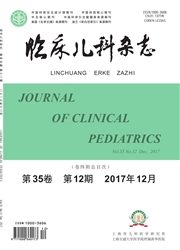

 中文摘要:
中文摘要:
目的 探讨CCLG-ALL-2008方案治疗TEL/AML1融合基因阳性儿童急性淋巴细胞白血病(ALL)效果以及影响因素。方法 回顾分析2008年6月至2014年12月初诊并治疗的99例TEL/AML1融合基因阳性患儿及329例无特异性融合基因的B系ALL患儿的临床和生物学特征,随访至2015年10月,观察两组患儿的生存状态和影响因素。结果 两组患儿初诊时的年龄和外周血白细胞数相近;在诱导缓解治疗第8天的泼尼松敏感实验、第15天骨髓呈M3状态、第33天和第12周微小残留病灶(MRD)>1.0×10-3的比例两组患儿的差异均无统计学意义(P>0.05)。随访期间,TEL/AML1融合基因阳性患儿的复发率为14.14%(14/99),无特异性融合基因组为20.97%(69/329),差异无统计学意义(χ2=2.27,P=0.132);无特异性融合基因组病死率(16.72%)高于TEL/AML1融合基因阳性组(8.08%),差异有统计学意义(χ2=4.52,P=0.033)。TEL/AML1融合基因阳性组与无特异性融合基因组的5年总生存率(OS)分别为(86.1±4.9)%和(79.0±2.8)%,5年无复发生存率(RFS)分别为(80.7±5.1)%和(72.0±3.1)%,5年无事件生存率(EFS)分别为(78.9±5.1)%和(69.6±3.1)%,差异均无统计学意义(P>0.05)。COX模型分析显示第12周MRD水平是影响OS、RFS、EFS的独立预后因素(P均<0.001)。结论 接受CCLG-ALL-2008方案治疗的ALL患儿,TEL/AML1融合基因阳性是预后良好的指标,第12周MRD≥1.0×10-3应推荐更强烈的治疗方案。
 英文摘要:
英文摘要:
Objective To evaluate the predictive role of TEL/AML1fusion gene in protocol CCLG-ALL-2008and toidentify relevant factors influencing the outcome of ALL with TEL/AML1fusion gene.Methods Ninety-nine patients with ALLharboring TEL/AML1fusion gene(positive)and329cases without any specific fusion genes(negative)at diagnosis of B-lineageALL from June2008to December2014were enrolled and their clinical and biological features were analyzed.Following-upended in October2015,the survival status was calculated by K-M curve and prognostic factors were analyzed by COX model.Results There were no differences between the two groups in age,white blood cell at the diagnostic stage,and treatmentresponses at4time points,namely,prednisone good response on day8,M3status of BM on D15,and the minimal residualdisease(MRD)more than1.0×10-3on day33and12th week.During the follow-up period,the relapse rate was lower in thepositive group than that in the negative group(14/99vs69/329),the mortality rate of the negative group was twice of that in thepositive group(55/329vs8/99).The five-year overall survival(OS)rate,relapse-free survival(RFS)rate and event-free survival(EFS)rate of the positive group were(86.1±4.9)%,(80.7±5.1)%and(78.9±5.1)%,respectively,and(79±2.8)%,(72±3.1)%,and(69.6+3.1)%for the negative group as well.COX regression analysis indicated that relapse and MRD level at the12th week were independent prognostic factors on OS,RFS,and EFS(P<0.05)for the two groups.Conclusions TEL/AML1fusion genecould be regarded as a relatively good indicator of risks in ALL children treated by CCLG-ALL-2008protocol.ALL patientswith TEL/AML1are recommended to receive more intensive therapy including hematopoietic stem cell transplantation when thepatients were high level of MRD on the12th week after treatment.
 同期刊论文项目
同期刊论文项目
 同项目期刊论文
同项目期刊论文
 期刊信息
期刊信息
